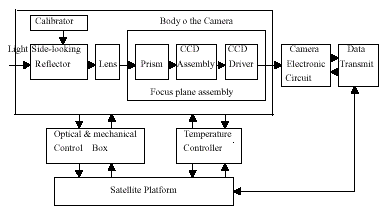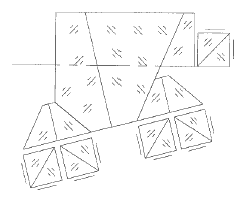| GISdevelopment.net ---> AARS ---> ACRS 1999 ---> Mapping From Space |
CCD Camera for CBERS
Deluo Lin, Shaochun Cui
Beijing Institute of Space Machine and electricity
P. O. Box 9201, Beijing 100076,China
Tel: 68382803, Fax: 68382807
E-Mail: bjcast@public.bta.net.cn
Beijing Institute of Space Machine and electricity
P. O. Box 9201, Beijing 100076,China
Tel: 68382803, Fax: 68382807
E-Mail: bjcast@public.bta.net.cn
Abstract
This paper introduces briefly the CCD Camera for the China/Brazil Earth Resource Satellite (CBERS) and its design and technical features. It is scheduled to space along with launching of CBERS on October 1999.
Introduction
CCD Camera is one of main instruments in China/Brazil Earth Resource Satellite (CBERS). It is used to take the earth ground scenes photographed by push-broom scanning, on 778km sun synchronous orbit, simultaneously obtaining blue, green, red and near infrared band images and one panchromatic image. The ground pixel resolution of each band is 20m. MTF at characteristic spatial frequency (38.5lp/mm) is 0.25. Swath width is 113km.The imager has about 6000 effective pixels the global coverage period is 26 days. There is a side-looking reflector mounted in front of the lens. The spindle set of reflector paralleling with flight direction. It can be turned an angle around its axis, so that photographing range on earth will turn to left-wards or right-wards 32 degrees. When necessary, the ground photographic range can be adjusted to widen the recycle observing capability over special interesting area where is taking place natural disaster. The range of side-looking area can reach 1100km; Maximum repeated cycle is 5 days. It causes the camera have some function of stereo-triangulation. Data transmitter of the Camera transmits the signal to the ground station by 8bit encoded data. The designed lifetime of the camera is two years. The spectral range of every band of the CCD Camera is at below. (Table 1.)
The main subsystems of the CCD camera consist of optical system, beam splitting system, CCD devices and CCD imaging electronic circuit etc. The auxiliary subsystems of the CCD camera are side-looking reflector, relative calibration mechanism, focusing device, temperature controller with their structures, control circuits, remote control and remote measurement circuits and interfaces, and power units etc. They are divided into four packages mounted on the interior of the satellite, that is the body of camera, optical and mechanical control box, temperature controller, and CCD imaging circuit. Fig 1 is picture of optical path of the CCD Camera. Fig 2 is block diagram of the CCD Camera system.
Table 1. CCD Camera Design Description

Figure 1. The Picture of the Optical Path

Fig 2 Block diagram of CCD Camera
The lens is the core of the camera for absorbing light energy of the ground scenes imaging in focus plane. The Camera uses Fairchild Company CCD143A Array, the diminution of CCD pixel is 13µm*13m. According to satellite flying height, ground pixel resolution, photographic swath and s/n ratio, it is obtained that the focus length is 520mm, angle of view 8.4° , relative aperture 1/4. For these requirements, It uses 8 pieces of lenses to form a Double Gauss Transmission Lens. As multi-spectral earth resource satellite camera, there exist a higher quality demands to the lens. The MTF of every band at CCD characteristic frequency for fitted up lens of the camera which measured by Ealing optical instrument reached 0.60. In the front of the lens, there is a protect lens of quartz optical glasses to guarantee the lens out of the affection of space radiation particles and to reduce the affection of environmental temperature.
In focus mechanism, there is a prismatic decomposition system splitting the incidence light into four color-beams and one panchromatic beam. The CCD array for every band mounted at the focus plane after prism. Fig 3 is conceptual diagram of splitter prism butted prism and CCD structure. Four multi-spectral array lines at the same direction to the ground scene, while panchromatic beam is in another field symmetric to optical axis. Apart from red, green and near infrared bands, especially it places a blue band (0.4µm – 0.52µm) which is sensitive to coloring material of plant of chlorophyll and phylloerythrin, suitable for measurement of water permeation. It is better for use in drowning map of coastal seawater area and distinguishing soil and vegetation cover especially deciduous plant and acicular plant The CCD device transfers the received light energy into photoelectron. Then the photoelectric signals are been processing in sampling, amplifying, filtering, composition of even and odd, and encoding by CCD imaging circuit. Finally via data transmission device the processed signals is been transferring to the ground stations.

Figuer 3. The Conceptual Diagram of CCD Splitter
Relative calibration device consists of lamp and illuminating optical system. It uses the multistage-stable light- source regularly illuminating optical system and CCD array, checks the changes of radiant character of the camera, the result are provided for radiant correction of image.
Conclusion
The CCD camera is a product of high technology, so it is more difficult in research and development. In order to do the task better, special works to resolve the key technologies are done and also doing optimization in system designation. Every kind of necessary tests concluding flight dynamic environment test, thermal vacuum test, and focusing test in vacuum condition, have been done in developing period. The results of tests demonstrated that the performances of the CCD camera fulfill the mission requirements, and the reliability is good. After research and development in many years, the CCD camera is expected to flight in orbit with CBERS after the satellite shall have been launching at late of 1999. Then doing test in orbit and providing daily routine application. It will be the first generation of long-life CCD camera in space for China.
This paper introduces briefly the CCD Camera for the China/Brazil Earth Resource Satellite (CBERS) and its design and technical features. It is scheduled to space along with launching of CBERS on October 1999.
Introduction
CCD Camera is one of main instruments in China/Brazil Earth Resource Satellite (CBERS). It is used to take the earth ground scenes photographed by push-broom scanning, on 778km sun synchronous orbit, simultaneously obtaining blue, green, red and near infrared band images and one panchromatic image. The ground pixel resolution of each band is 20m. MTF at characteristic spatial frequency (38.5lp/mm) is 0.25. Swath width is 113km.The imager has about 6000 effective pixels the global coverage period is 26 days. There is a side-looking reflector mounted in front of the lens. The spindle set of reflector paralleling with flight direction. It can be turned an angle around its axis, so that photographing range on earth will turn to left-wards or right-wards 32 degrees. When necessary, the ground photographic range can be adjusted to widen the recycle observing capability over special interesting area where is taking place natural disaster. The range of side-looking area can reach 1100km; Maximum repeated cycle is 5 days. It causes the camera have some function of stereo-triangulation. Data transmitter of the Camera transmits the signal to the ground station by 8bit encoded data. The designed lifetime of the camera is two years. The spectral range of every band of the CCD Camera is at below. (Table 1.)
The main subsystems of the CCD camera consist of optical system, beam splitting system, CCD devices and CCD imaging electronic circuit etc. The auxiliary subsystems of the CCD camera are side-looking reflector, relative calibration mechanism, focusing device, temperature controller with their structures, control circuits, remote control and remote measurement circuits and interfaces, and power units etc. They are divided into four packages mounted on the interior of the satellite, that is the body of camera, optical and mechanical control box, temperature controller, and CCD imaging circuit. Fig 1 is picture of optical path of the CCD Camera. Fig 2 is block diagram of the CCD Camera system.
| Band | Wave length µ m | Radiance w/m2·sr |
S/N db | |||
| Multispectral band | Max | Min | Max | Min | ||
| B1 | 0.42~0.52 | 28.7 | 4.6 | 48 | 32 | |
| B2 | 0.52~0.59 | 30.1 | 3.7 | 50 | 31 | |
| B3 | 0.63~0.69 | 25.9 | 2.4 | 48 | 26 | |
| B4 | 0.77~0.89 | 35.6 | 2.7 | 52 | 29 | |
| Panchromatic band | B5 | 0.51~0.73 | 55.6 | 9.0 | 53 | 37 |

Figure 1. The Picture of the Optical Path

Fig 2 Block diagram of CCD Camera
The lens is the core of the camera for absorbing light energy of the ground scenes imaging in focus plane. The Camera uses Fairchild Company CCD143A Array, the diminution of CCD pixel is 13µm*13m. According to satellite flying height, ground pixel resolution, photographic swath and s/n ratio, it is obtained that the focus length is 520mm, angle of view 8.4° , relative aperture 1/4. For these requirements, It uses 8 pieces of lenses to form a Double Gauss Transmission Lens. As multi-spectral earth resource satellite camera, there exist a higher quality demands to the lens. The MTF of every band at CCD characteristic frequency for fitted up lens of the camera which measured by Ealing optical instrument reached 0.60. In the front of the lens, there is a protect lens of quartz optical glasses to guarantee the lens out of the affection of space radiation particles and to reduce the affection of environmental temperature.
In focus mechanism, there is a prismatic decomposition system splitting the incidence light into four color-beams and one panchromatic beam. The CCD array for every band mounted at the focus plane after prism. Fig 3 is conceptual diagram of splitter prism butted prism and CCD structure. Four multi-spectral array lines at the same direction to the ground scene, while panchromatic beam is in another field symmetric to optical axis. Apart from red, green and near infrared bands, especially it places a blue band (0.4µm – 0.52µm) which is sensitive to coloring material of plant of chlorophyll and phylloerythrin, suitable for measurement of water permeation. It is better for use in drowning map of coastal seawater area and distinguishing soil and vegetation cover especially deciduous plant and acicular plant The CCD device transfers the received light energy into photoelectron. Then the photoelectric signals are been processing in sampling, amplifying, filtering, composition of even and odd, and encoding by CCD imaging circuit. Finally via data transmission device the processed signals is been transferring to the ground stations.

Figuer 3. The Conceptual Diagram of CCD Splitter
Relative calibration device consists of lamp and illuminating optical system. It uses the multistage-stable light- source regularly illuminating optical system and CCD array, checks the changes of radiant character of the camera, the result are provided for radiant correction of image.
Conclusion
The CCD camera is a product of high technology, so it is more difficult in research and development. In order to do the task better, special works to resolve the key technologies are done and also doing optimization in system designation. Every kind of necessary tests concluding flight dynamic environment test, thermal vacuum test, and focusing test in vacuum condition, have been done in developing period. The results of tests demonstrated that the performances of the CCD camera fulfill the mission requirements, and the reliability is good. After research and development in many years, the CCD camera is expected to flight in orbit with CBERS after the satellite shall have been launching at late of 1999. Then doing test in orbit and providing daily routine application. It will be the first generation of long-life CCD camera in space for China.